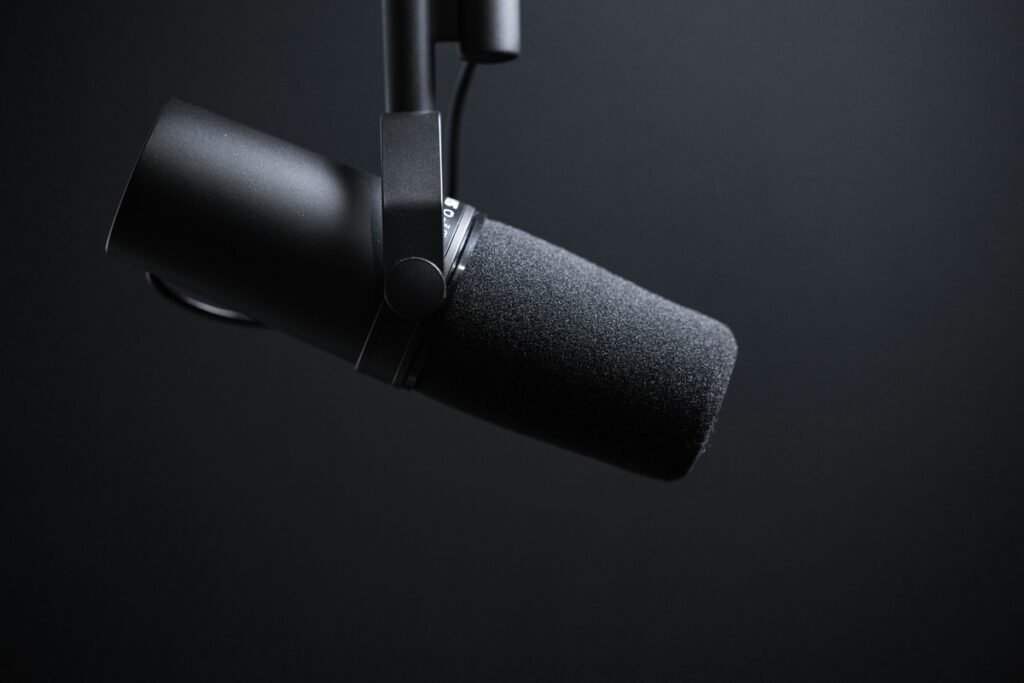Hey there, future podcast stars! If you’re entering the world of podcasting, you’ll need a microphone that captures your voice with clarity and precision. After all, your stories, interviews, and insights deserve to be delivered with the best possible sound quality.
Selecting the right podcast microphone can transform your audio from amateur to professional, setting the stage for your brand to shine. Whether you’re working on a tight budget or have a bit more to play with, rest assured there are stellar options out there for everyone.
In this guide, we’re going to explore a variety of podcast microphones that cater to different budgets and setups, ensuring you find the perfect gear that elevates your episodes. Let’s uncover the best microphone for podcasting that promises a crisp and clear listening experience for your audience!
Types of Podcast Microphones
When it comes to selecting the best microphones for podcasting, understanding the types of microphones available is crucial. Let’s dive into the two main types that podcasters typically choose from.
Dynamic Microphones
Dynamic microphones are the workhorses of the audio world. They’re known for their durability and ability to handle high sound pressure levels without distortion, making them a go-to choice for recording in less-than-ideal acoustic environments.
Dynamic mics, like the Shure SM58, are excellent at isolating sound and rejecting background noise, making them perfect for podcasters who might record in busy or noisy settings. They require no external power, which adds to their practicality and ease of use in various locations.
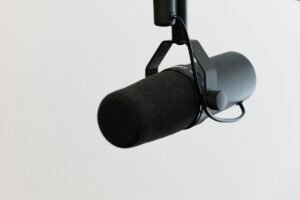
Condenser Microphones
On the other hand, condenser microphones are highly regarded for their sensitivity and capacity to capture detailed audio with a broad frequency range. This makes them ideal for studio environments where controlling background noise is feasible.
Although condensers, like the Audio-Technica AT2020, offer exceptional sound quality and depth, they are often more susceptible to picking up ambient noise. They typically require phantom power, especially when connected via XLR, but USB versions simplify usage with plug-and-play capability.
Budget Podcast Microphones (Under $100)
If you’re just starting out and watching your spending, there are several excellent budget-friendly podcast microphones under $100. These options marry affordability with performance, and they provide a solid entry point into podcasting without compromising audio quality.
Samson Q2U
- Price: Around $69.99
- Connection Type: USB and XLR
- Mic Type: Dynamic
- Pros: Versatile dual connectivity, portable, cost-effective
- Cons: Lower gain compared to professional-grade mics
The Samson Q2U offers both USB and XLR connectivity, making it a versatile choice for beginners. This microphone shines with its ease of use and dual output, allowing you to alternate between USB for direct computer recording and XLR for professional audio interfaces as your setup grows. Its design is beginner-friendly, ensuring you can capture clear audio without a significant upfront investment.
MXL 990
- Price: About $70
- Connection Type: XLR
- Mic Type: Condenser
- Pros: Good sound quality, affordable, durable
- Cons: Picks up background noise, requires a boom arm
The MXL 990 is a great entry-level condenser microphone that gives a rich, warm audio quality that’s perfect for studio settings. It’s particularly effective in quieter spaces due to its sensitivity to sound nuances. Although it has a more fragile build compared to more rugged dynamic mics, it’s an excellent choice if you’re after that full, studio-quality sound on a budget.
Audio-Technica ATR2100x
- Price: Approx. $79.99
- Connection Type: USB and XLR
- Mic Type: Dynamic
- Pros: Dual connectivity, portable, strong build quality
- Cons: Availability can vary
The ATR2100x is similar to the Samson Q2U, offering both USB and XLR support. This makes it a handy choice for podcasters looking to enjoy flexibility in recording using computer software or more advanced setups. The solid build coupled with convenient portability makes the ATR2100x an all-rounder for both home studios and on-the-go capturing of interviews.
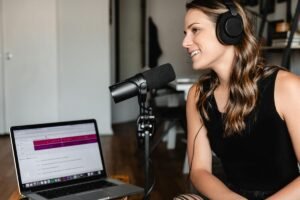
Blue Snowball
- Price: Around $49.99
- Connection Type: USB
- Mic Type: Condenser
- Pros: Easy to use, recognizable design, affordable
- Cons: Sound quality may not rival other options, design preference may vary
The Blue Snowball’s ease of setup and attractive price tag have made it a favorite among novice podcasters. This USB condenser mic doesn’t offer professional sound quality, but it provides decent audio clarity for essential podcasting needs, particularly in quieter environments. Its distinctive design is an added bonus for those who appreciate aesthetics.
Shure SM58
- Price: Approximately $99
- Connection Type: XLR
- Mic Type: Dynamic
- Pros: Built-in pop filter, rugged design, reliable sound quality
- Cons: Primarily known as a live performance mic, it requires an XLR connection
Renowned for its robustness, the Shure SM58 is a highly dependable choice. Its ability to withstand harsh treatment and performance in various conditions make it a great option for mobile podcasting. With a built-in pop filter, it captures warm, clear sounds without picking up excess background noise, making it a versatile addition to any podcaster’s toolkit.
Audio-Technica AT2020
- Price: Just under $100
- Connection Type: XLR
- Mic Type: Condenser
- Pros: Rich audio quality, affordable, versatile
- Cons: Needs external power & boom arm, may pick up background noise
The Audio-Technica AT2020 continues to be a staple in many recording setups due to its high-quality audio output and reasonable price tag. This condenser microphone captures vocals with rich detail, making it a fantastic choice for those focused on achieving studio-quality sound on a budget. However, its sensitivity means care must be taken to control the recording environment to minimize ambient noise.
These budget microphones present a range of options to cater to different needs and help ensure excellent audio quality from the start, without breaking the bank. Whether you’re recording solo, on the move, or setting up a mini-home studio, there’s a choice here perfect for your needs while staying well within a beginner’s budget.
Mid-Range Podcast Microphones ($100-$200)
Rode Podcaster
- Price: Around $230
- Connection Type: USB
- Mic Type: Dynamic
- Pros: Excellent sound quality, robust build, ideal for podcasting
- Cons: Heavier, limited portability
The Rode Podcaster is a staple in many podcasting setups, thanks to its excellent sound quality and durability. As a dynamic microphone, it is perfect for reducing background noise, allowing your voice to come through clear and crisp. However, its weight and the need for good support equipment can be a downside if you’re always on the move.
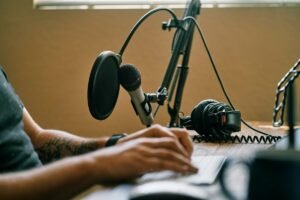
Rode Wireless Micro
- Price: Approximately $200
- Connection Type: Wireless (integrates with Android or iOS)
- Mic Type: Lavalier
- Pros: Easy on-the-go use, good for video podcasting, reliable wireless
- Cons: Potentially less robust than stand-mounted mics
The Rode Wireless Micro is a fantastic choice for podcasters wanting mobility. Its seamless wireless integration with smartphones makes it an excellent option for impromptu interviews or vlogs. While it can’t match the build quality of desktop mics, its convenience makes it a favored option for podcasters on the move.
Blue Yeti
- Price: About $130
- Connection Type: USB
- Mic Type: Condenser
- Pros: Versatile, high-quality sound, multiple pattern settings
- Cons: USB only, can pick up background noise
The Blue Yeti is legendary in the podcasting world, known for its versatility and ease of use. It offers multiple polar patterns, making it suitable for solo or group recordings. However, because it’s a condenser mic, it might capture ambient noise if your recording environment isn’t ideal.
AKG Lyra
- Price: Approximately
- 150−
- 150−160
- Connection Type: USB
- Mic Type: Condenser
- Pros: Superb sound quality, multiple polar patterns
- Cons: Availability might be an issue in certain regions
The AKG Lyra stands out with its exceptional sound quality for the price, often praised for its clarity over competitors like the Blue Yeti. It’s flexible with different recording patterns, making it a solid option for various recording setups. Its elegance and performance make it a strong contender in the mid-range segment.
PreSonus Revelator Dynamic
- Price: Roughly $150
- Connection Type: USB
- Mic Type: Dynamic
- Pros: Great background noise control, user-friendly
- Cons: USB only, which may limit professional setups
The PreSonus Revelator Dynamic is designed to handle less-than-ideal recording conditions. This dynamic mic offers built-in features to reduce noise and reverb, making it a great choice for those without a dedicated recording booth. While USB only, its audio-processing capabilities offer a lot to beginners and intermediate podcasters alike.
Sennheiser Profile
- Price: Around $130
- Connection Type: USB
- Mic Type: Condenser
- Pros: Sleek design, good audio quality
- Cons: Setup challenges with some software
The Sennheiser Profile is a sleek option for those looking to seriously upgrade their podcast audio quality. It delivers both excellent sound and intuitive control, although initial setup might require a bit of troubleshooting. Despite its small size, it offers some of the best sound in its price category.
Samson Q9U
- Price: Approximately $200
- Connection Type: USB/XLR
- Mic Type: Dynamic
- Pros: Dual connectivity, excellent sound
- Cons: Larger than some other dynamic mics
The Samson Q9U offers the best of both worlds with its dual USB/XLR functionality. This dynamic mic provides high-quality sound, making it perfect for both beginners and experienced podcasters transitioning to more advanced setups. Its size may be larger compared to other mics, but it doesn’t sacrifice sound quality.
Rode NT1
- Price: Roughly $270
- Connection Type: XLR
- Mic Type: Condenser
- Pros: Superb audio fidelity, low noise
- Cons: Requires an audio interface
The Rode NT1 is celebrated for its near-silent operation and unparalleled sound fidelity. Perfect for studio environments, this condenser microphone captures voice in rich detail. You’ll need an audio interface for this XLR mic, which adds to the cost but significantly boosts the audio quality.
PreSonus PX-1
- Price: Around $120
- Connection Type: XLR
- Mic Type: Condenser
- Pros: Affordable, excellent for controlled environments
- Cons: Requires soundproof environment/setup
For those with a good recording environment, the PreSonus PX-1 offers excellent sound quality at an affordable price. As a large diaphragm condenser mic, it’s ideal for capturing vocals with clarity. However, its sensitivity requires careful acoustic management.

Premium Mics ($200+)
Shure MV7+
- Price: Approximately $249
- Connection Type: USB/XLR
- Mic Type: Dynamic
- Pros: Excellent sound isolation, versatile connectivity
- Cons: Pricey, lacks advanced software integration
The Shure MV7+ builds on the success of its predecessor by adding additional features that enhance usability and sound clarity. Its versatility in connectivity—both USB and XLR—coupled with robust podcast-centric features make it a top choice for serious podcasters.
Rode NT1 5th Gen
- Price: Around $250
- Connection Type: USB/XLR
- Mic Type: Condenser
- Pros: Unclippable audio, dual connectivity
- Cons: Higher learning curve for technology
The Rode NT1 5th Gen is designed to be nearly foolproof with its unclippable 32-bit float digital output. It allows for adjustments post-recording, making it an excellent choice for those who prioritize flexibility in post-production.
Apogee HypeMic
- Price: About $349
- Connection Type: USB
- Mic Type: Condenser
- Pros: Built-in compression tools, portable design
- Cons: Pricey, may not suit all podcasting needs
The Apogee HypeMic stands out with its built-in compression features meant to level out your recording, minimizing the need for post-production. However, some settings may not suit all users, which could require experimentation for the best output.
Electro-Voice RE20
- Price: Roughly $450
- Connection Type: XLR
- Mic Type: Dynamic
- Pros: Rich sound quality, durable build
- Cons: Requires good preamp
The Electro-Voice RE20 is a legend among broadcasters, known for its rich, naturally resonant audio quality. It is a fantastic option for those who want broadcast-quality sound, though its full potential is achieved with a top-notch preamp and interface setup.
Heil PR40
- Price: Approximately $327
- Connection Type: XLR
- Mic Type: Dynamic
- Pros: Top-tier audio quality for dynamic range
- Cons: Overhyped in professional circles
Though often spoken of in glowing terms, the Heil PR40 might not be everyone’s ideal. Its prowess lies in providing excellent audio reproduction with minimal background noise, especially in less controlled settings.
Rode Wireless Pro
- Price: Around $400
- Connection Type: Wireless
- Mic Type: Lavalier (with included lav mics)
- Pros: Complete mobile setup, high-quality recording
- Cons: High cost, overkill for static setups
Beyond standard lavaliers, the Rode Wireless Pro system offers an extensive kit allowing full mobility with premium audio quality. It’s perfect if your recording setup requires high mobility or you’re producing content in diverse locations.
Lewitt RAY
- Price: Estimated $300
- Connection Type: USB
- Mic Type: Dynamic
- Pros: Advanced technology for sound positioning, intuitive design
- Cons: Higher price for unique features
The Lewitt RAY brings innovation with built-in laser technology to help maintain optimal sound capture even if the user moves around. This technology is unique and adaptable for dynamic recording setups, though it may drive up costs unnecessarily in simpler environments.
Shure SM7B
- Price: Approximately $399
- Connection Type: XLR
- Mic Type: Dynamic
- Pros: Legendary audio quality, robust build
- Cons: Needs robust preamp
The Shure SM7B remains the holy grail for many podcasters looking for seamless, studio-quality audio. It’s a preferred choice for its ability to handle a wide range of audio challenges, giving you reliability with its robust build. However, it does require a high-quality preamp to shine.
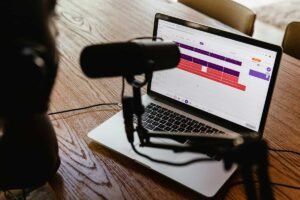
How to Pick the Right Podcasting Microphone for You?
Starting your podcasting journey is an exciting endeavor, and choosing the right microphone is one of the first and most crucial steps. The right microphone can elevate your sound quality from amateur to professional, and believe me, your listeners will notice the difference. With such a variety of options available, it’s important to consider several factors to find the microphone that best suits your needs. Here’s a helpful guide to get you started.
Determine Your Recording Environment
Your recording environment plays a pivotal role in determining the best type of microphone for you. Are you recording in a soundproof studio, or are you working in diverse locations that might expose you to background noise? This consideration will influence whether you opt for a dynamic or condenser microphone.
- Dynamic Microphones: Ideal for live recordings and environments with potential background noise. These microphones are great at isolating sound and focusing on what’s directly in front of them, making them perfect for home studios that may not have top-notch soundproofing. For podcasters who are constantly on the move or in action-packed locations, a dynamic mic could be your best friend.
- Condenser Microphones: These are best suited for controlled and quiet studio environments. They capture a wide range of frequencies and are more sensitive to subtle sounds, providing excellent detail and depth. However, they’re also more likely to pick up background noises, so they may require a quieter space to truly shine.
Consider Connectivity Options: USB vs. XLR
The next essential factor is connectivity. How you connect your microphone to your recording device affects your setup’s complexity and flexibility.
- USB Microphones: These are perfect for beginners or those who need simple plug-and-play functionality. USB mics connect directly to your computer and are incredibly user-friendly, often requiring no additional equipment. They are a great starting point for anyone who wants to dive into podcasting without getting bogged down by technology.
- XLR Microphones: These are typically used in more professional settings. XLR mics often offer higher sound quality, but they require additional gear like an audio interface or mixer to connect them to your computer. They provide more flexibility and control—a great option if you’re aiming for professional-grade recordings.
Additionally, some microphones, like the Samson Q2U, offer both USB and XLR connectivity, allowing for versatility as your podcasting needs evolve.
Assess Your Budget
Budget is always an important consideration. The podcasting microphone market offers a wide range of options, from budget-friendly models to high-end, professional mics. Here’s a quick breakdown to help you navigate:
- Budget Models: Affordable options like the Samson Q2U or the ATR2100x deliver great quality without breaking the bank. These are excellent starting points, and their dual connectivity offers room for growth.
- Mid-Range Options: Microphones like the Shure MV7 provide excellent sound quality with both USB and XLR connections, giving you flexibility while still being relatively straightforward to use.
- High-End Choices: If you’re looking to invest in a top-tier setup, models like the Shure SM7b offer superior audio quality but require additional equipment for optimal performance.
Final Thoughts
Choosing the right microphone involves a thoughtful analysis of your personal needs and circumstances. Whether you lean towards a USB mic for its simplicity or an XLR mic for professional-grade audio, ensuring the microphone matches your recording environment and setup preferences is key. Remember, a good microphone is a worthwhile investment that significantly enhances your podcast’s audio quality, making your content more engaging and enjoyable for your audience. Happy podcasting!

